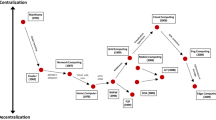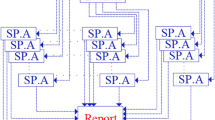Abstract
Grid is a network of computational resources that may potentially span many continents. Maximization of the resource utilization hinges on the implementation of an efficient load balancing scheme, which provides (i) minimization of idle time, (ii) minimization of overloading, and (iii) minimization of control overhead. In this paper, we propose a dynamic and distributed load balancing scheme for grid networks. The distributed nature of the proposed scheme not only reduces the communication overhead of grid resources but also cuts down the idle time of the resources during the process of load balancing. We apply the proposed load balancing approach on Enhanced GridSim in order to gauge the effectiveness in terms of communication overhead and response time reduction. We show that significant savings are delivered by the proposed technique compared to other approaches such as centralized load balancing and no load balancing.
Similar content being viewed by others
References
Nazir B, Qureshi K, Manuel P (2008) Adaptive fault tolerant job scheduling strategy for economy based grid, J Super Comput (October): 116–134
Qureshi K, Hussain SS (2008) A comparative study of parallelization strategies for fractal image compression on a cluster of workstations. Int J Comput Methods 5(3):463–482
Rehman A, Qureshi K, Manuel P, Rashid H (2008) Resource topology aware GridSim: a step ahead. J Comput 19(2):13–22; special issue on Grid and Cluster Computing
Foster I, Kesselman C, Tuecke S (2001) The anatomy of the Grid: enabling scalable virtual organization. Int J High Perform Comput Appl 15(3):200–222
Berman F, Fox G, Hey AJ (2003) Grid computing: making the global infrastructure a reality. Wiley, New York
Hussain S, Qureshi K, Rashid H (2009) Local predecimation with range index communication parallelization strategy for fractal image compression on a cluster of workstations. Int Arab J Inf Technol 6(3):293–296
Arif Wani M, Arabnia HR (2003) Parallel edge-region-based segmentation algorithm targeted at reconfigurable multi-ring network. J Supercomput 25(1):43–63
Bhandarkar SM, Arabnia HR (1995) The Hough transform on a reconfigurable multi-ring network. J Parallel Distrib Comput 24(1):107–114
Qureshi K, Manuel P (2007) Adaptive pre-task scheduling strategy for heterogeneous distributed raytracing system. Int J Comput Electr Eng 33:70–78
Lu K, Subrata R, Zomaya AY (2006) An efficient load balancing algorithm for heterogeneous grid systems considering desirability of grid sites. In: Proceedings of the 25th IEEE international conference on performance, computing, and communications, 10–12 April 2006
Fernandes de Mello R, Senger LJ, Yang LT (2006) A routing load balancing policy for grid computing environments. In: Proceedings of the 20th international conference on advanced information networking and applications (Aina’06), vol 1, 18–20 April, 2006
Touzene A, Al Yahia S, Day K, Arafeh B (2005) Load balancing grid computing middleware. In: IASTED international conference on web technologies, applications, and services (WTAS 2005), Calgary, Canada, July 2005
Krauter K, Buyya R, Maheswaran M (2002) A taxonomy and survey of grid resource management systems for distributed computing. Softw Pract Exp 32:135–164
Yagoubi B, Slimani Y (2007) Task load balancing strategy for grid computing. J Comput Sci 3(3):186–194
Li Y, Lan Z (2005) A survey of load balancing in grid computing. In: Lecture notes in computer science, vol. 3314. Springer, Berlin, Heidelberg, pp 280–285
Quetier B, Cappello F (2005) A survey of Grid research tools: simulators, emulators and real life platforms. In: Proceeding of 17th IMACS world congress (IMACS 2005), Paris, France
Murshed M, Buyya R, Abramson D (2001) GridSim: A toolkit for the modeling and simulation of global grids. Technical Report, Monash, CSSE
Yagoubi B, Slimani Y (2006) Dynamic load balancing strategy for grid computing. Trans Eng Comput Technol 13:260–265
Yagoubi B, Slimani Y (2007) Load balancing strategy in grid environment. J Inf Technol Appl 1(4):285–296
Payli RU, Yilmaz E, Ecer A, Akay HU, Chien S (2006) DLB—a dynamic load balancing tool for grid computing, scalable computing. Pract Exp 7(2):15–23
Author information
Authors and Affiliations
Corresponding author
Rights and permissions
About this article
Cite this article
Qureshi, K., Rehman, A. & Manuel, P. Enhanced GridSim architecture with load balancing. J Supercomput 57, 265–275 (2011). https://doi.org/10.1007/s11227-010-0402-6
Published:
Issue Date:
DOI: https://doi.org/10.1007/s11227-010-0402-6




